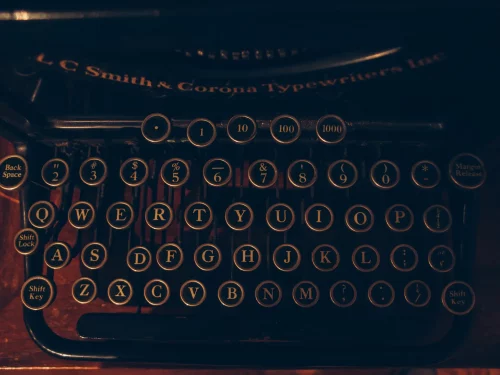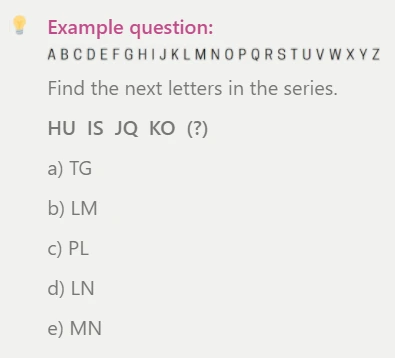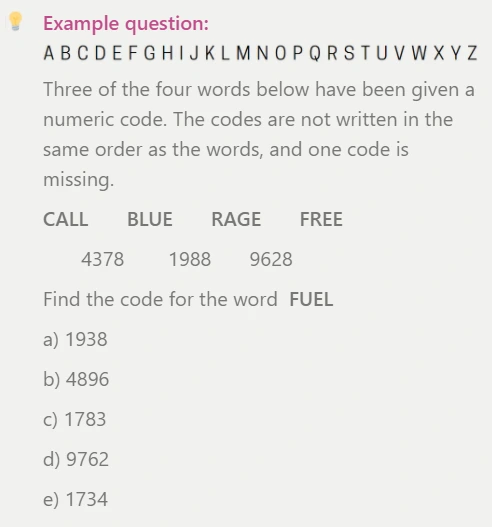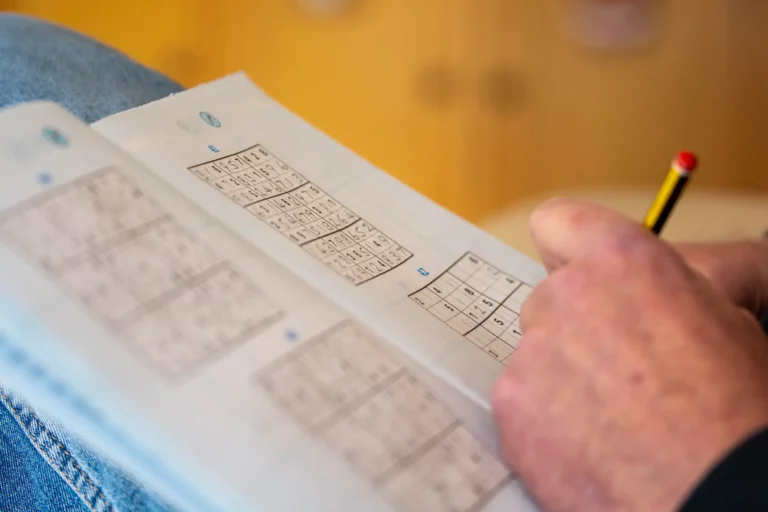6 Tips to help your child master 11+ Verbal Reasoning Codes

What are codes?
Code questions are types of questions that are used to test pupils’ Verbal Reasoning skills in GL 11+ exams. These questions involve working out codes (made from letters or numbers) based upon given patterns. Code questions can seem daunting at first, but by following our top tips, as well as having a little practice, your child can master them in no time.
There are four different types of code question that may be asked in a GL 11+ exam, and each is described below.

Type 1: Crack the letter code

In the first type of code question you will be given a word and its corresponding code. You will then be asked to find the code for a given word (or do the opposite: find the word for a given code) by applying the same pattern.
For example in the question on the left, the code for KEYS is ICWQ, and we are asked to work out what word FYLB means when we follow the same pattern. In this instance each letter of the word is moved to 2 letters before in the alphabet, so FYLB means HAND.
Type 2: Complete the letter series

In the second type of code questions you will be presented with a series of two letter segments, and be asked to find the next two letters in the series.
In this example question the next letters would be LM because in the series, the first letter follows the alphabet from H-I-J-K-L, and the second goes backwards along the alphabet while skipping every other letter; U T S R Q P O N M.

Type 3: Complete the letter sentence

The third type of code questions asks you to complete a sentence by picking the two letters that will fit best. You work this out by inferring what the relationship is between the first two pairings of letters.
In the example question, the answer is US because to get from CA to JH you have to add 7 to both letters – therefore if you add 7 to NL, you get US.
Type 4: Crack the number code

In the fourth type of codes numbers are introduced. Here you have to work out the code for a word based on three other codes you’ve been given.
In the example question, from the codes we’re given we can work out that 8 is E because it is the last letter of three of the four words we’re given. In the word FUEL, E is the third letter, so we just have to find the answer that contains E as the third letter, which is 1783.

Tips & Techniques
1. Work out the difference between the letters in the word and the code
In every question where we are asked to work out a code, we are first given an example of the code being used, for example in type 1 we’re told that the code for KEYS is ICWQ. Therefore, the key to answering these types of questions is working out the differences between each letter in the word and its equivalent in the code, for example, I (ICWQ) comes 2 letters before K (KEYS) in the alphabet.
It is important to look at each individual letter in the word (and its code equivalent) rather than the word or code as a whole, as the letters might not all follow the same pattern. This technique is relevant for question types 1-3.
2. Mirror code (alternative method for type 1/3)
Usually tip 1 should be a sufficient technique to help you master the first three types of code questions. However, occasionally the examiners like to throw a spanner in the works and change it up a bit.
In question types 1 and 3, instead of moving each letter along in the alphabet, they may instead choose to use a mirror code. This means splitting the alphabet in two, with the boundary in the middle between M (which stands for middle) and N. The way to work out the code is then to count whatever letter mirrors the one you have, for example, if you have P, the mirrored letter would be K, as they are both three from the middle.

The questions where they choose to do this are often easy to identify as the differences between each letter will be much larger than usual. For example if E is codified as V, which is 17 letters away from it in the alphabet, we can assume that a mirror code is being used. In this instance we can see that E is the fifth letter of the alphabet, and V is five from the end, and therefore they are clearly mirrored, and we can apply that same process to the code that we are trying to work out.
Watch out!
A common error that people can make is to get confused as to whether the question is asking you to find a word or its code. This can change for each question, even within the same section of questions, and therefore it is really important to read each question carefully. The reason why this is important is that it will determine whether you go forwards or backwards in the alphabet to find your answer, based upon what happens in the given example.
3. Leapfrog method (standard method for type 2)
Type 2 (complete the letter series) is pretty straightforward once you know how to do it. The key is to remember to focus on the first letter of each segment, and find the pattern between all of them, and then focus on the second. Often the pattern will just follow the alphabet in descending or ascending order, eg B-C-D-E. However if it doesn’t, the leapfrog method may come in handy. This is when the sequence jumps over every other, or every two or three letters, eg B-D-F-H.

4. Elimination method
Most 11+ exams follow a multiple choice format, meaning that you have to pick the correct answer from 5 options. By using the elimination method you can save time by eliminating options that are impossible as you work out each part of the code.
For example if you’re doing a type 4 question and work out that the code you’re looking for has an 8 as the third number, you can eliminate any option which does not have this. As a result you might be able to find the answer without even having to work out the whole code, and can save time and move on to the next question.
5. Make sure you make a real English word!
If you are given a code and have to find out the word it means, one of the best ways to know if you’ve worked out the code effectively is to check whether you have actually made a real English word, or just a random assortment of letters.
For example if the code is BME, you can quickly tell that moving each letter forward by one is incorrect as it would make CNF, which is not a word, whereas if you move them forward twice, you find DOG, which is a word – and a pretty good one at that! 🐶

6. Don’t panic!
Sometimes when you open a Verbal Reasoning exam paper and are presented with a seemingly random assortment of letters or numbers, it may feel like you’re reading gibberish and make you not want to even bother attempting it.
But remember! There is a logic to all of these codes and if you just take a deep breath and remember all of the tips we’ve provided you with here, finding the answer should be pretty straightforward, especially if you keep practising regularly.
